7-4 Alphabet Knowledge
The fourth early literacy component is alphabet knowledge, also known as letter knowledge.
Knowing the alphabet is one of the Big Five predictors of, and necessary skills for, the development of reading and writing. It consists of two parts: recognizing and writing letters. For children who are multilingual learners, educators must make sure they have access to their home language’s form of written expression both at home and school. Using the alphabet for writing, not just copying letters, helps young children focus on the function and form of the alphabet.
How were you taught letters of the alphabet as a child? How have you taught it?
Early Indicators of Alphabet Knowledge
Languages use a multitude of ways to capture thoughts, words, and ideas. Many languages value oral language; others value written language.
English, for example, heavily values written forms of communication. Educators need to consider this when working with children who are multilingual learners, especially to recognize that such children may speak a language that values oral forms of communication.
Children show they can distinguish the special characteristics of print communication, apart from pictures, when they can:
- Differentiate shapes, colors, and sounds.
- Sing parts of the alphabet song.
- Become familiar with letter sounds.
- Identify distinguishing features of letters.
- Recognize that the alphabet has a certain order.
- Realize letters are written down in a certain direction.
Fostering Children’s Alphabet Knowledge
The National Association for the Education of Young Children (NAEYC) and the International Reading Association (IRA) stress that meaningful and fun activities best enhance children’s alphabet knowledge.
Memorizing letters is neither fun nor meaningful, and consequently doesn’t teach children to read.
Letter recognition
Start letter recognition with words familiar and meaningful to children, like their names! Where do you have children’s names in your classroom? For example, one teacher puts names on objects that are related to each learning center. She put children’s names on paint stirrers in the art center and on rulers in the math center.
Think about using puzzles in your classroom. How could you make puzzles out of children’s names for them to play with at centers?
Video: Using Names During Circle Time
Here’s an example (1:27) of an educator dismissing children from circle time to centers. As you watch the video, think about ways the educator is increasing children’s alphabet knowledge. Have you used similar strategies in your own early learning setting?
Alphabet Toys and Books
Many alphabet toys and books can be placed in relevant and accessible locations around children’s learning environments both at school and at home. Include all the languages the children speak. For children who may need more support, consider having children work in small groups so peers, siblings, or friends can play together with alphabet toys and books.
If toys aren’t available in a child’s home language, teachers can partner with families to make similar ones using the letters or characters of their language. Again, represent all languages children in the classroom speak. This causes children to feel more welcome, comfortable, confident, and included.
How have you, or can you, incorporate alphabet toys in your own classroom?
Letters
In addition to alphabet toys, you can display letters for children to reference and manipulate throughout the classroom. In this classroom letters are readily available near the writing center. Consider using glue and fabrics to create tactile images and letters children can feel and trace with their fingers. You can use tactile picture books and create labels in Braille.
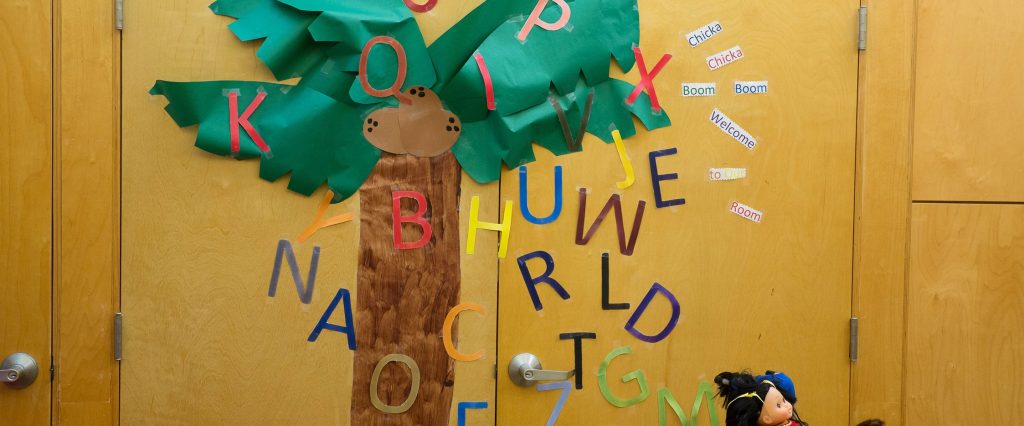
In this set-up, letters are always available to point out when talking with children.
Early Alphabet Knowledge
Early alphabet knowledge is also closely related to writing. Look at these examples of a child’s early writing.
The example on the left was obtained early in the school year and the sample on the right after the winter holidays.
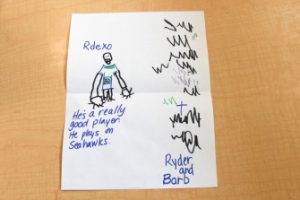
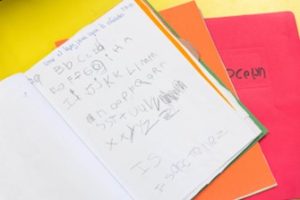
- What does this child know about the alphabet?
- What does the child know about literacy? How do you know?
- How might this child have learned about the alphabet and literacy?
If you see a child who is a multilingual learner creating letter-like forms and scribbling, make sure you share it with the child’s family. They may recognize letters and words in their language, so then the child’s home language skills can be documented and built upon in the classroom.
Writing Centers
Because of the close connection between writing and alphabet knowledge, early education centers can benefit by adding writing centers as one of the daily choices in the classroom. For example, educators can place a booklet of the children’s pictures with their names and a booklet of words that are targets in the current theme-based curriculum at the writing center.
For children who may need additional support, consider using adaptive seating or positioning to make sure they are comfortable and stable when drawing or writing. Use tape or Velcro to stabilize paper. Make writing tools easier to manipulate. Add large foam grips or wrap masking tape around crayons, markers, and brushes so they’re easier to hold. Use letter stamps or magnetic letters.
Infants and toddlers should also have access to non-toxic drawing and writing instruments so they can explore them through their senses and learn to make marks with them.
Crayons and markers can be placed in clothes pins that have been hot-glued on the sides of toys for fun and function so that children can easily access them and write whenever they feel inspired.
Creating Writing Experiences
Any experience can become a writing experience. In addition to self-talk, the educator can self-write their words. They can also capture children’s thoughts and expressions in writing, usually in large enough print so the child can see the letters being formed into words. This technique is known as a language experience approach. Again, language experience approaches must be engaged in both home and classroom languages.
When using a language experience approach in children’s home languages, parents, caregivers and educators can incorporate children’s funds of knowledge. For instance, languages such as Arabic, Kurdish, Hebrew, and Urdu read from right to left. Languages such as Chinese, Japanese, and Korean are flexible in the direction they are read.
Additionally, adults at home and school can model for children using writing for real purposes like sending notes, writing reminders, making lists, or journaling.
Recording a Child’s Thoughts
Here, a teacher modeled writing by recording a child’s thoughts on a topic. This is a great example of a child’s perspective and the nature of their explanations.
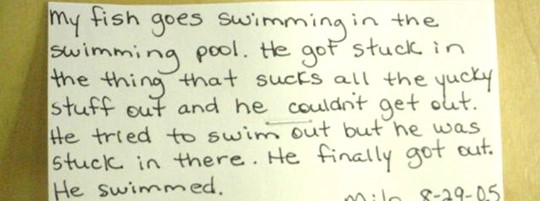
“My fish goes swimming in the swimming pool. He got stuck in the thing that sucks all the yucky stuff out and he couldn’t get out. He tried to swim out but he was stuck in there. He finally got out. He swimmed [sic].”
This is another example of modeling writing. The child wrote his name on this picture and the teacher recorded his verbal description by writing, “See stars. I am happy. I made me with a shirt red.”
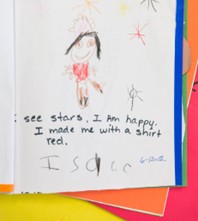
This is also an opportunity for teachers to collaborate with parents or caregivers to practice writing the same text in the child’s home language(s).
Writing to Make Center Choices
Here is an example of encouraging children’s alphabet knowledge through writing when it comes to center choices. Ask children to write their name beside their choice of centers. It’s helpful for children to see their names, but they learn even more when they get to write it and think about the letter names and shapes.
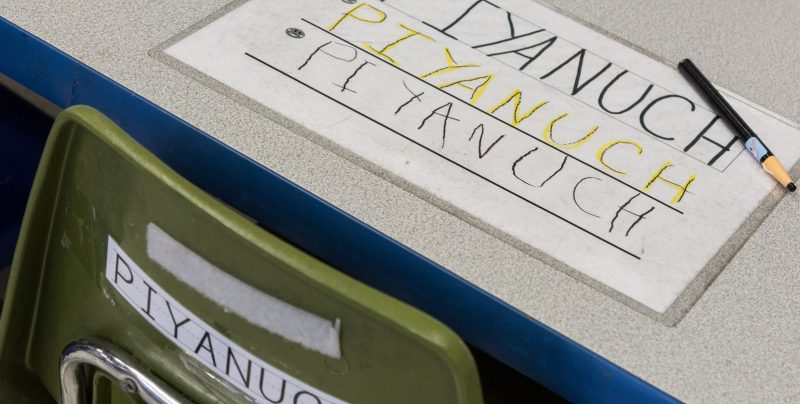
When a center is full, you can also ask children to write their names on waiting lists. Giving children many opportunities to see and write their names throughout the day will help them develop alphabet knowledge in fun and meaningful ways!
What do you think about the idea of giving children an opportunity to write their names on a list at different centers to indicate they want a turn?
Display and Talk About Children’s Writing
Display children’s writing and drawing. Read to the whole class the stories children wrote, or have the children read to each other and act out stories they wrote. Looking at children’s writing over time helps educators see their progress in alphabet knowledge and other foundations of literacy.
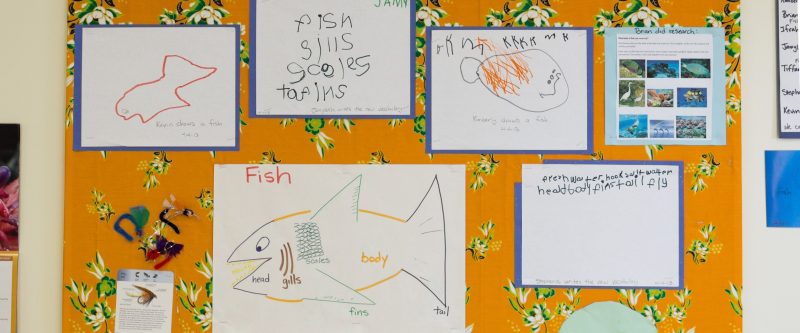
Encourage children to write in their home language so they feel welcome and learn that their language is equally as valuable as English. This is crucial.
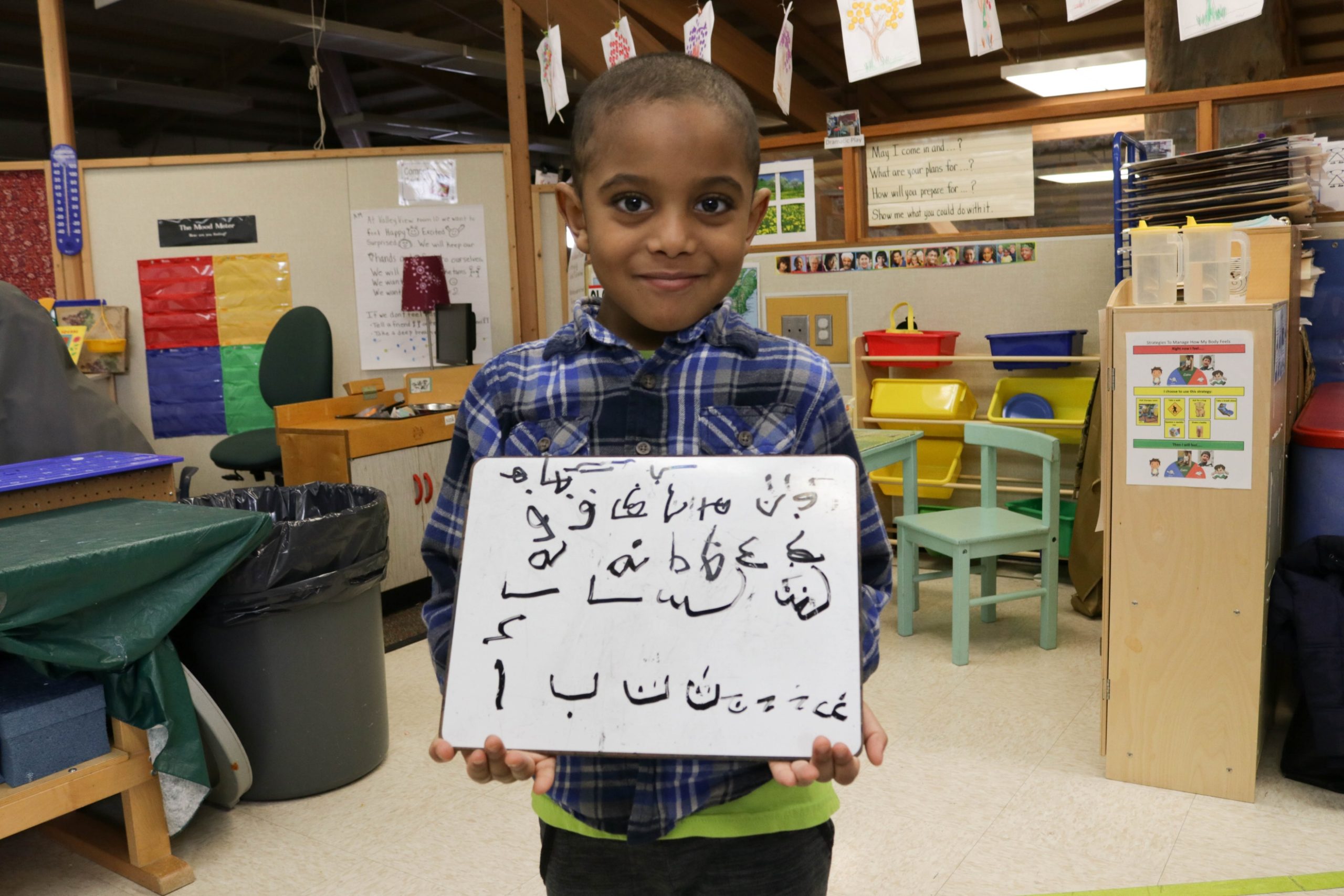 This picture shows a child who practiced writing in Arabic on a whiteboard (look at how proud he feels!).
This picture shows a child who practiced writing in Arabic on a whiteboard (look at how proud he feels!).
On your own, brainstorm even more ideas to use in your own classroom. Jot down activity ideas to help children develop alphabet knowledge.
Think about your program. Are there helpful activities your program already does? How about in your own schooling? Have you observed another educator engaging in an activity you liked? How about activities you learned from home and/or community spaces?
Individualized Support
Some children may need more systematic learning opportunities to help them learn print-related skills. Read the Big 5 Supplement about Alphabet Knowledge and Early Writing by the National Center on Early Childhood Development, Teaching, and Learning to learn more about embedded teaching and intensive individualized teaching for children with disabilities who are multilingual learners.
references
Andiamo! (2019). Resources: Right to left languages. [Website]
Byington, T. & Kim, Y. (2017, November). Promoting Preschoolers’ emergent writing. Young Children(72)5. [Online article]
Cultivate Learning, University of Washington. (2019). Alphabet Knowledge Example [Video file].
International Reading Association & National Association for the Education of Young Children (1998, May). Learning to read and write: Developmentally appropriate practices for young children. [PDF]
National Center on Early Childhood Development, Teaching, and Learning (2019). The Big 5 Highly individualized teaching supplements: Alphabet knowledge and early writing. [PDF]
Cite this source:
EarlyEdU Alliance (Publisher). (2020). 8-4 Alphabet Knowledge. In Supporting Multilingual Learners Course Book. University of Washington. [UW Pressbooks]

